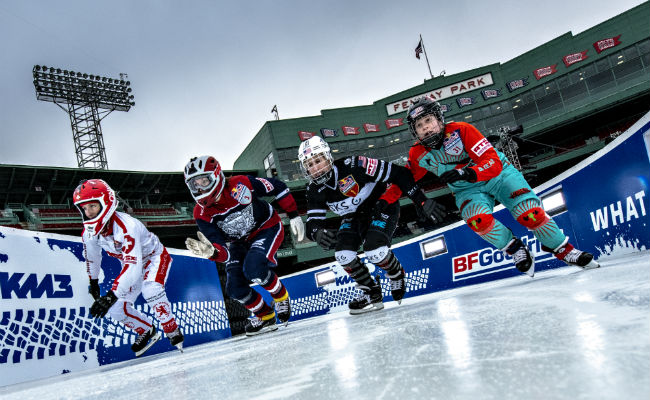
BOSTON — Count me among those that think Fenway Park is full of ghosts. Well, at least one ghost that maybe has a fascination with Anne Frank.
On the first weekend of February my personal ghost was the sound I heard all over the oldest Major League park in America. It kind of sounded like the last distorted horns of Neutral Milk Hotel’s Holland, 1945. Maybe you’re a weirdo like me and know exactly the sound I’m talking about from an indie rock album released 21 years ago. For the rest of you, well, there’s YouTube.
I’d hear the subtle whine from In The Aeroplane Over The Sea all over Fenway — in the press box behind home plate, the media room on the mezzanine level and, somehow, in the concourse. At first I thought it was the sound of doors opening. But I heard it where there are no doors, like during an interview I frantically recorded in a Fenway Park bathroom. When I was transcribing the quotes a week later, I audibly gasped. I wasn’t crazy. Something was following me around the park the two days I spent covering Red Bull Crashed Ice at the ballpark that opened the day the Titanic sank in 1912.
But this isn’t a ghost story, as I never did track down the noise and where it came from as I took in two days of downhill ice racing in one of my favorite places on the planet. This is about the places we watch sports and what makes them both special and highly marketable.

I first visited Fenway with my family in 2007, the day after July 4. By then the Red Sox had broken the Curse of the Bambino and were on their way to winning a second title in four years when I dragged my parents and sister to Boston on a family vacation, then through Back Bay to take a tour of Fenway and see the Sox bomb out the Devil Rays a day after watching fireworks explode over the Charles.
More than a decade later, I live in Boston and have seen dozens of games in America’s Most Beloved Ballpark. I’ve seen David Ortiz hit playoff home runs and saw his No. 34 get retired there forever. But Fenway has become much more than a ballpark — it’s hosted numerous concerts and the third Winter Classic. Harvard and Yale played The Big Game there last fall. Liverpool has “hosted” Roma there — the Reds and the Red Sox share the same ownership group — and even hurling has called Fenway home.
Sports fans attach a certain reverence to the places their favorite teams play. It’s something we can’t help, really, as the backdrop for our sports memories can become as important as the people on the field that make them. It’s why people get engaged at games or have wedding receptions at stadium where their alma mater plays on Saturdays in the fall. But stadiums are just vessels, things to fill with people and places containing the boundaries we need to play the games we love. Constructing them a century ago was as loveless a process as how Jerryworld or Barclays Center or any modern venue gets built these days. But the older the venue, the more we allow our own ghosts to soak into the beams and concrete and fading green paint to feel more alive.
There was nothing nostalgic about Crashed Ice in Boston. The scaffolding for the course’s covered most of the right field bleachers, including temporary pillars directly behind the famous red seat where Ted Williams once hit a home run 502 feet in 1946. Fenway’s iconic Green Monster sat dark during the two-day event. But for Red Bull, using that nostalgia as a backdrop for Crashed Ice is an easy marketing angle, and it gives the sport a platform that, quite frankly, it hasn’t had before.
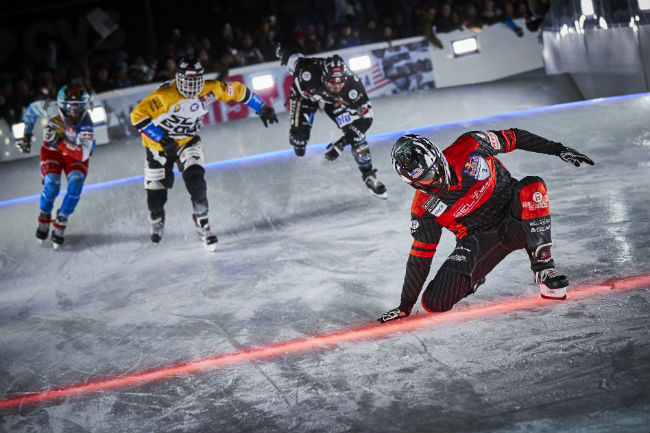
Crashed Ice is a downhill ice cross event, with the Red Bull-sponsored championships symbolic of the top flight of the sport. The goal is to get down the course first, as fast as you can go while wearing hockey pads and skates that let you tear down the course and avoid crashing out on the artificial ice. Smaller All Terrain Skate Cross (ATSX) events often are put on at ski resorts, using the contours of the hill to shape the course’s ups and downs and turns. The Red Bill Crashed Ice races have taken place all over the world, but its usual backdrop for its biggest events is the cityscapes of those places. The tracks aren’t inside sporting venues, but built on the streets of places like Marseille, France and Jyväskylä, Finland.
As Cameron Naasz, a two-time world champion who won the men’s championship at Crashed Ice Boston last month pointed out, transforming a city street into an icy race course can be an expensive and tedious endeavor for organizers.
“It’s not sustainable to put on such an expensive event in the middle of a city,” the Minnesota native said. “By doing it in Fenway Park we’re avoiding permits and all the other expenses that come with shutting down the city for a fair amount of time.”
Naasz said something that was echoed by many people over the weekend: Ballparks like Fenway aren’t exactly hosting many events in the winter months when Crashed Ice needs a place to play.
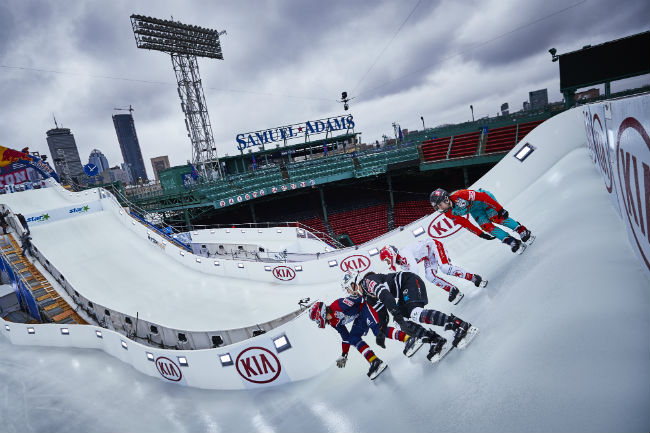
“The ballparks are just sitting here all winter,” Naasz said. “Why not use them?”
Later in the weekend he later commended Fenway for being “progressive” in planning events during the months the Red Sox aren’t playing — the park hosted a Big Air snowboard and skiing event in 2016 with a 140-foot jump for competitors paired with a concert. Looking back, it’s a natural progression from Big Air to Crashed Ice, both in scale and extreme nature of the sport itself.
Hilary Knight, another Red Bull athlete and herself a figurehead of women’s hockey in America, understands how important marketing is to drawing the eyes of curious sports fans. Plus, as a forward for the Boston Pride, Knight certainly understands how iconic Fenway Park is.
“It’s the melding of two worlds,” Knight said. “I mean, people travel here just to touch Fenway. And then you are this new, up and coming fastest sport on ice. This extreme sport. Putting those together is pretty cool.”
You can see for yourself how it turned out on Red Bull’s TV channel — the venue makes for picturesque views and the sport looks great on TV. But building in a baseball park does mean some challenges, both for designers of the course and people watching the action in the park. Taking a lap around the park during the action revealed that there’s no seat in the building where you can see all of the action. That’s because the nearly 1,200-foot course needs to fit in a park where the deepest part of the park is 420 feet to deep center field.
“There had to be a turnaround: you need to find 350 meters,” Nass said. “That’s why it loops around.”
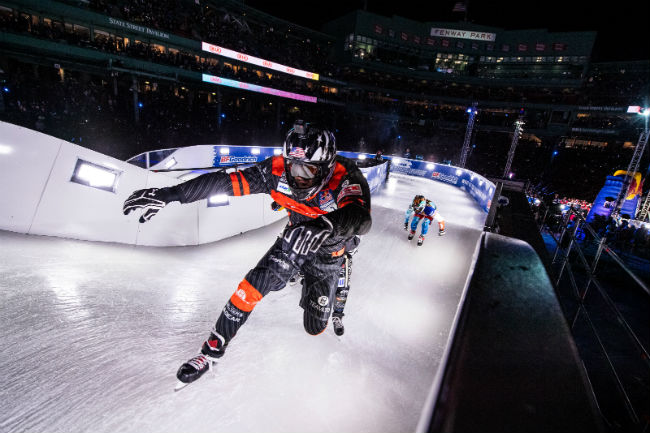
Those in the park’s upper deck along the first base line got the best view of the action, but everyone needed to watch video boards at some point, whether the one on the back of the half pipe-style turn before the course’s loop under the starting line or in center field. Though Friday night’s freestyle and juniors competition saw sparse attendance, the finals for the men’s and women’s events had roaring crowds who saw Americans sweep the competition and draw “USA” chants from the Fenway faithful.
After the rings were handed out, Naasz and Amanda Trunzo spoke to how difficult it is to cross-train for Crashed Ice. A former Olympic hockey player, Trunzo is the current women’s world champion and won the women’s title at Fenway on Saturday night. She told reporters she does CrossFit 5-6 days a week, works out at a gym with a skating treadmill to practice jumps, and also visits a skatepark to work on body control at least once a week. And then there’s hockey, twice a week on top of her full-time job that pays most of the bills.
Naasz is another hockey-first player who’s brought in CrossFit and aerial work through training at a skate park. But as Knight found out when she tried the course along with her Pride teammates, it isn’t easy to skate on ice ramps without training. Hockey players just aren’t taught to jump on skates — it can be dangerous, and unless there’s a puck going over your head or someone to avoid on the ice, it isn’t necessary. But it’s everything on a course where speeds can exceed 50 miles per hour and losing momentum — or worse, falling — means losing a race.
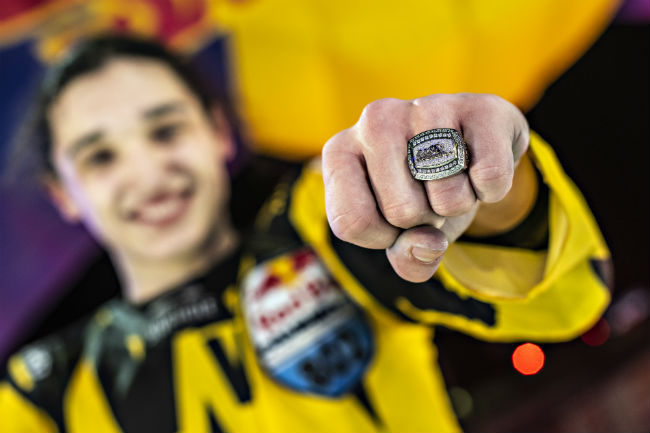
For Naasz and Trunzo, it took years to understand how to take rolling ice hills and move your body in the air with blades on your feet. Naasz pointed to the next generation of ice cross skaters like Johanny “JoJo” Velasquez, who won the juniors title and competed in the men’s senior competition and freestyle skills event as well, as the future of the sport because “he’s been training by having fun his whole life.”
It’s not an absurd statement, either. Velasquez, a senior in high school from State College, Penn., is the son of an X Games rollerblader who said he’s “been skating pretty much since I’ve been able to walk” and started playing hockey at age 10.
“I like to say I’ve been training for a sport I didn’t know existed,” said Velasquez, who found out about Crashed Ice and started competing a year ago. “I found about the sport and said ‘this is me.’”
Velasquez said he’s excited to see what the sport has in store for him once he graduates and focuses more on his training. Maybe it’s a sport that will one day have a ghost-filled venue of its own to call home.






